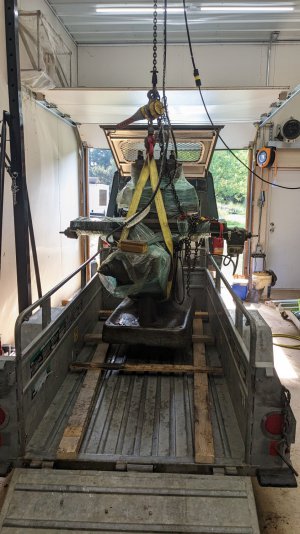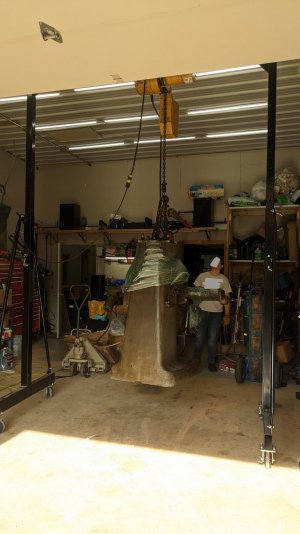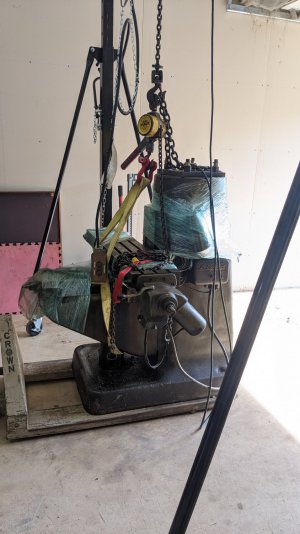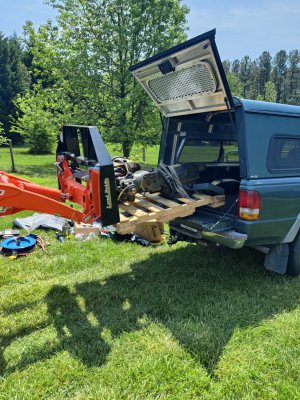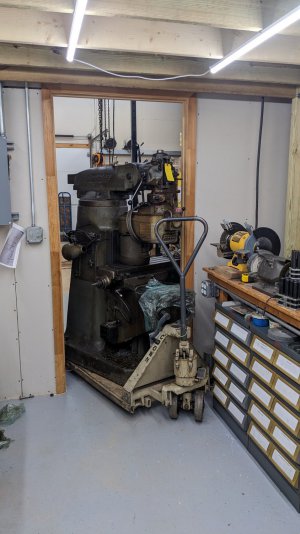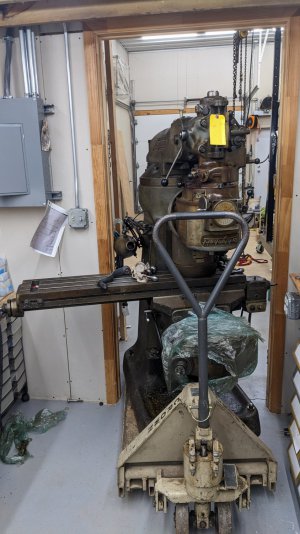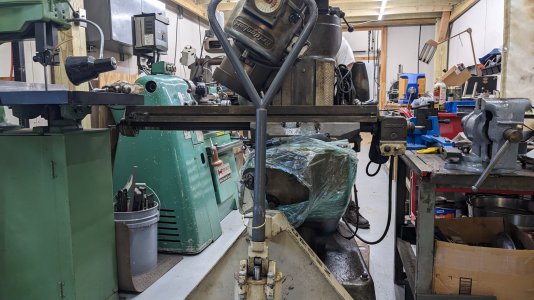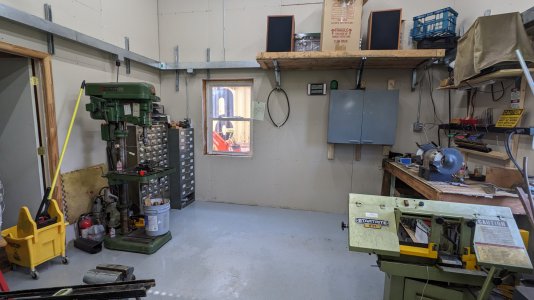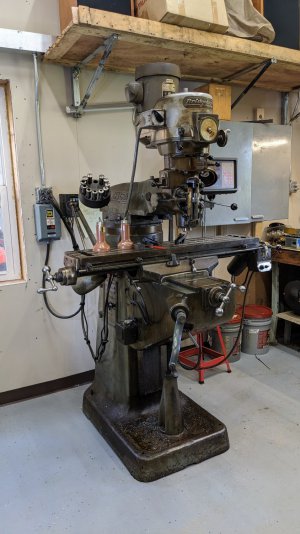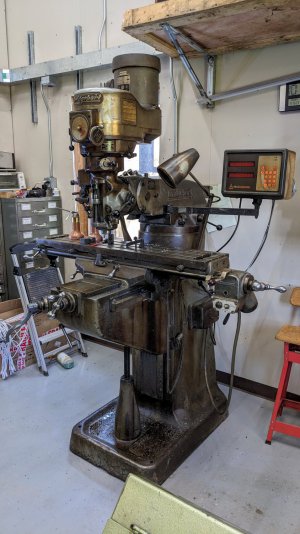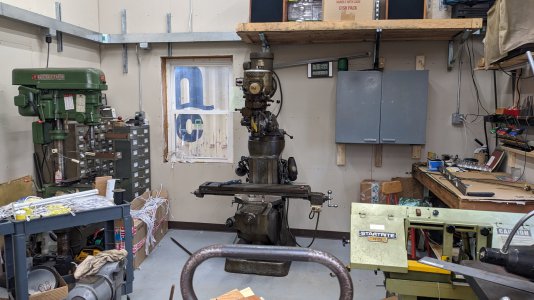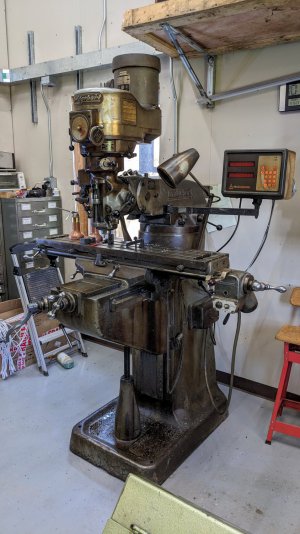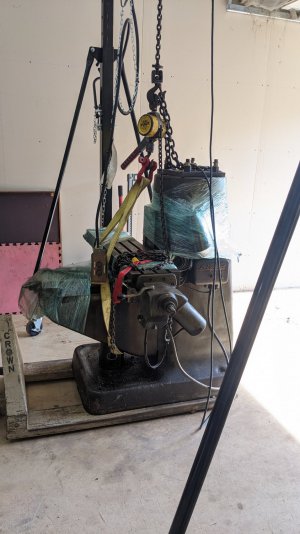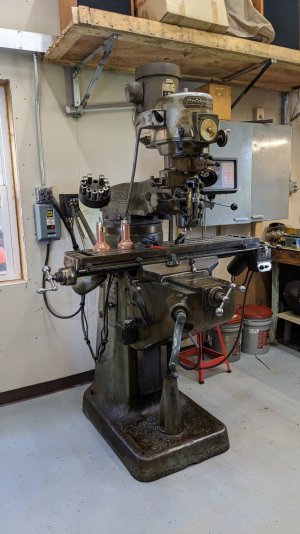- Joined
- Oct 30, 2019
- Messages
- 197
This writeup is split over two posts in this thread due to the attachment limit
--
"today" (now a few weeks ago), I picked up a series 1 2J head Bridgeport I bought at an auction in the Chicagoland area, and drove it home to Northern VA.
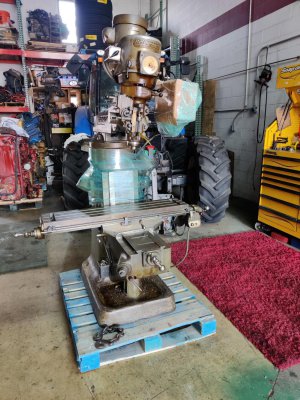
Originally when I bought the machine, it was at the same time that a friend bought a machine in the same auction. They were equipped with a tractor trailer (the owner of their shared shop is a truck driver) and 40ft shipping container borrowed for the day, so picking up 2 mills was trivial and it was only 10 minutes from their shop. The idea was that they would house my purchase, and probably be able to get it to hitchhike from Chicago to my neighborhood on a friend's truck for free or very cheap.
For a variety of small reasons, this ended up being a bit too complicated - the biggest issue was not having a forklift at home to unload the machine with, from someone else's truck parked on our rural side road -- which also would not be able to turn around to leave the area. Various ways to solve that ended up getting expensive or complicated (tight coupling of schedules and reliance on peoples' capabilities/flexibilities)
So I researched the size/proportions/footprint/weight/etc of the machine, best practices for moving, and decided that I could tow it home myself. The main decision was whether to use my cheap 2000lbs GVW utility trailer, including buying a spare tire and wheel bearing for the trip; or to rent a trailer. This ended up being a no-brainer, the Uhaul 4x7 trailer rental was only about $100 for 4 days, and the trailer is much better designed/built than mine - which makes sense since it is a rental that is expected to be problem free and take no risks that could create unnecessary liability for Uhaul. Their trailer weighs about 600 lbs, and is rated for 1800 lbs payload.
I expected the mill to be 2000-2200 lbs, which by itself is more than I'd really like to tow this distance and with the mountains in MD/PA; plus it is over the payload capacity of either trailer option. Larger trailers get a lot heavier too, further adding to my total towed mass....
There was a decent solution -- take the entire ram/head off the column of the machine, this should be 400-600 lbs; and put it in the bed of the truck. This is great not only for reducing the weight of the trailer, but also putting weight in the bed of the truck for substantially better weight distribution/highway behavior.
The drive out to Chicago was uneventful, 15 hours almost non-stop just 2 stops for food and gas. The UHaul utility trailers are not offered for one-way use, so I rented it locally and towed it out empty, which was fine.
To prepare for loading, we swing the head upside down...
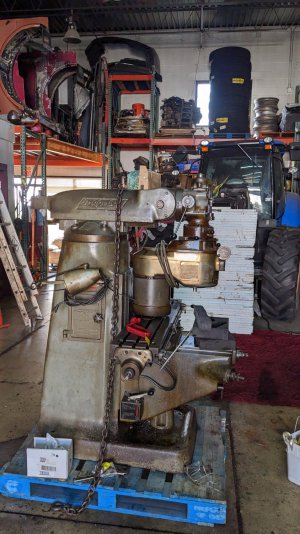
The Bridgeport sure looks small compared to their forklift.
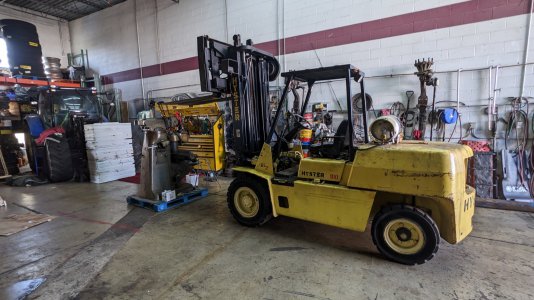
And then took the weight of it with the shop's large forklift, and a come-along for balancing:
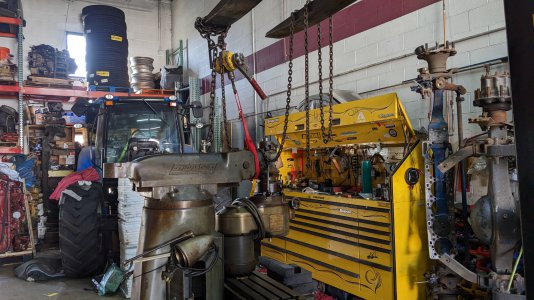
4 bolts later, and the ram assembly was fully removed. We lowered it onto a pallet I brought with me that perfectly fits in the bed of the truck between the wheel wells in the bed
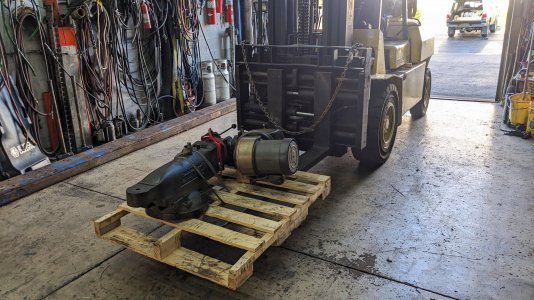
Then threaded that pallet into the truck and pushed it all the way forward with the forks. I brought a crane scale with me so we could weight the two parts of the machine -- I am very risk-averse about towing and wanted to know exactly what my payload and weight distribution was. The head of the machine weighed somewhere between 500 and 550 lbs.
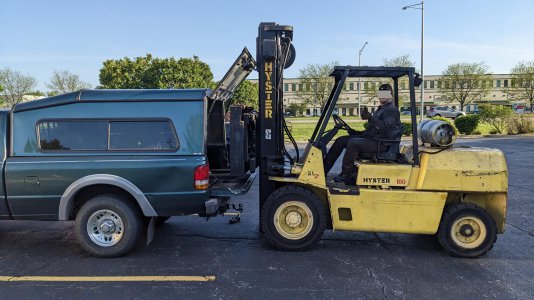
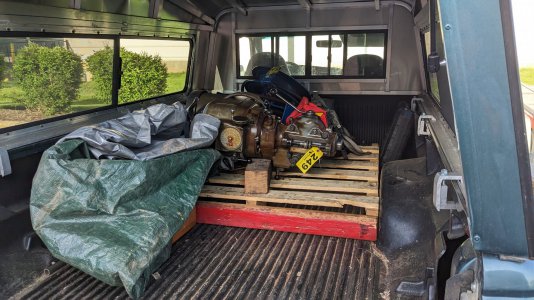
Next was loading the remaining carcass of the machine We spent some time making a plate to go on top of the column that would accept the 4 bolts that go down into the spider to clamp the top of the column and provide a solid lift point.
We found a combination of lug nuts and washers that made enough spacers to use the OEM bolts, which already were slightly bent so it seemed fine to use them for clamping the plate on. It's the same load they would see with the ram bolted on anyway, and that's the normal way to lift these.
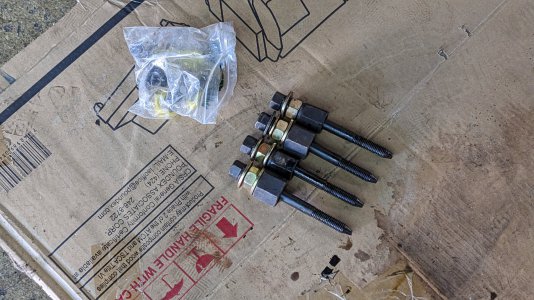
Then it was just a matter of lifting from that point and using the come-along to again level the load out
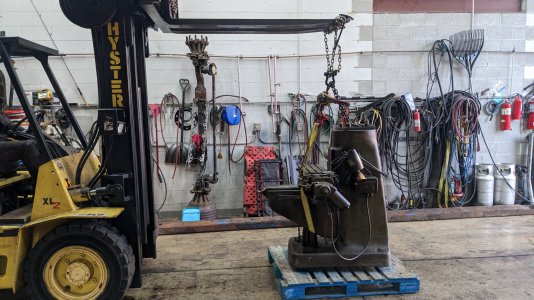
This tipped the scales at approximately 1350 lbs -- putting the total machine weight around 1900 lbs.
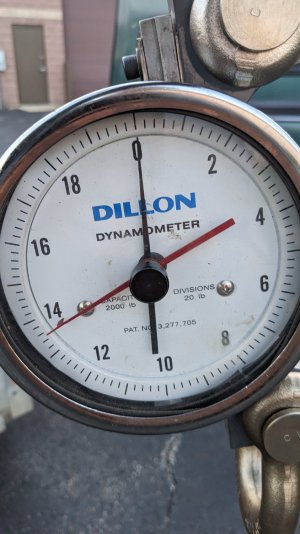
We backed the trailer into the shop and lowered the machine in, then used the crane scale and forklift to weigh the tongue and get about 225-275 lbs of tongue weight for a safe trip home.
Strapped it in, shrink-wrapped all the machined surfaces/ways to avoid road debris from accumulating...
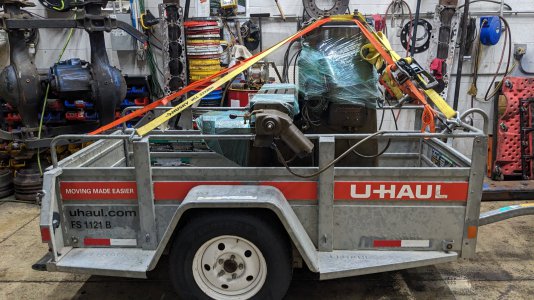
Then loaded all the tools/materials I brought back in the truck along with some other winnings from this auction and the stuff needed to make the trip back. My friend made the trip with me for a second set of hands, and to help unload/set up at my place. He hasn't run a mill before, so the trade-off is that we would get it set up faster and get some time on it (or if issues were encountered, on my smaller mill) so that he could get exposure to the fundamentals of machine setup and operation, and bring that knowledge back to the shared shop in Chicagoland.
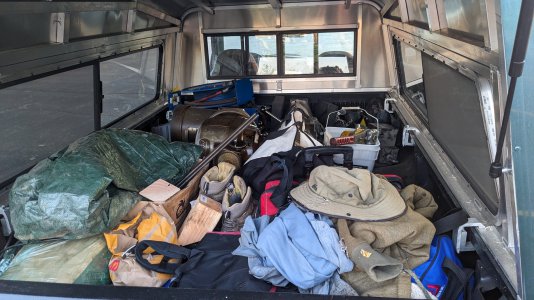
Topped off the tires on the truck (raised the pressure of the rears by about 5psi over normal), checked fluids and all other pre-roadtrip stuff, and got a good night of sleep for a ~4am departure the next day.
This story continues in another post below due to the attachment limit being hit in this post
--
"today" (now a few weeks ago), I picked up a series 1 2J head Bridgeport I bought at an auction in the Chicagoland area, and drove it home to Northern VA.

Originally when I bought the machine, it was at the same time that a friend bought a machine in the same auction. They were equipped with a tractor trailer (the owner of their shared shop is a truck driver) and 40ft shipping container borrowed for the day, so picking up 2 mills was trivial and it was only 10 minutes from their shop. The idea was that they would house my purchase, and probably be able to get it to hitchhike from Chicago to my neighborhood on a friend's truck for free or very cheap.
For a variety of small reasons, this ended up being a bit too complicated - the biggest issue was not having a forklift at home to unload the machine with, from someone else's truck parked on our rural side road -- which also would not be able to turn around to leave the area. Various ways to solve that ended up getting expensive or complicated (tight coupling of schedules and reliance on peoples' capabilities/flexibilities)
So I researched the size/proportions/footprint/weight/etc of the machine, best practices for moving, and decided that I could tow it home myself. The main decision was whether to use my cheap 2000lbs GVW utility trailer, including buying a spare tire and wheel bearing for the trip; or to rent a trailer. This ended up being a no-brainer, the Uhaul 4x7 trailer rental was only about $100 for 4 days, and the trailer is much better designed/built than mine - which makes sense since it is a rental that is expected to be problem free and take no risks that could create unnecessary liability for Uhaul. Their trailer weighs about 600 lbs, and is rated for 1800 lbs payload.
I expected the mill to be 2000-2200 lbs, which by itself is more than I'd really like to tow this distance and with the mountains in MD/PA; plus it is over the payload capacity of either trailer option. Larger trailers get a lot heavier too, further adding to my total towed mass....
There was a decent solution -- take the entire ram/head off the column of the machine, this should be 400-600 lbs; and put it in the bed of the truck. This is great not only for reducing the weight of the trailer, but also putting weight in the bed of the truck for substantially better weight distribution/highway behavior.
The drive out to Chicago was uneventful, 15 hours almost non-stop just 2 stops for food and gas. The UHaul utility trailers are not offered for one-way use, so I rented it locally and towed it out empty, which was fine.
To prepare for loading, we swing the head upside down...

The Bridgeport sure looks small compared to their forklift.

And then took the weight of it with the shop's large forklift, and a come-along for balancing:

4 bolts later, and the ram assembly was fully removed. We lowered it onto a pallet I brought with me that perfectly fits in the bed of the truck between the wheel wells in the bed

Then threaded that pallet into the truck and pushed it all the way forward with the forks. I brought a crane scale with me so we could weight the two parts of the machine -- I am very risk-averse about towing and wanted to know exactly what my payload and weight distribution was. The head of the machine weighed somewhere between 500 and 550 lbs.


Next was loading the remaining carcass of the machine We spent some time making a plate to go on top of the column that would accept the 4 bolts that go down into the spider to clamp the top of the column and provide a solid lift point.
We found a combination of lug nuts and washers that made enough spacers to use the OEM bolts, which already were slightly bent so it seemed fine to use them for clamping the plate on. It's the same load they would see with the ram bolted on anyway, and that's the normal way to lift these.

Then it was just a matter of lifting from that point and using the come-along to again level the load out

This tipped the scales at approximately 1350 lbs -- putting the total machine weight around 1900 lbs.

We backed the trailer into the shop and lowered the machine in, then used the crane scale and forklift to weigh the tongue and get about 225-275 lbs of tongue weight for a safe trip home.
Strapped it in, shrink-wrapped all the machined surfaces/ways to avoid road debris from accumulating...

Then loaded all the tools/materials I brought back in the truck along with some other winnings from this auction and the stuff needed to make the trip back. My friend made the trip with me for a second set of hands, and to help unload/set up at my place. He hasn't run a mill before, so the trade-off is that we would get it set up faster and get some time on it (or if issues were encountered, on my smaller mill) so that he could get exposure to the fundamentals of machine setup and operation, and bring that knowledge back to the shared shop in Chicagoland.

Topped off the tires on the truck (raised the pressure of the rears by about 5psi over normal), checked fluids and all other pre-roadtrip stuff, and got a good night of sleep for a ~4am departure the next day.
This story continues in another post below due to the attachment limit being hit in this post
Last edited:


